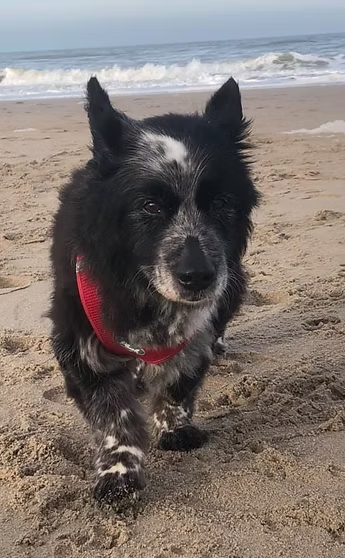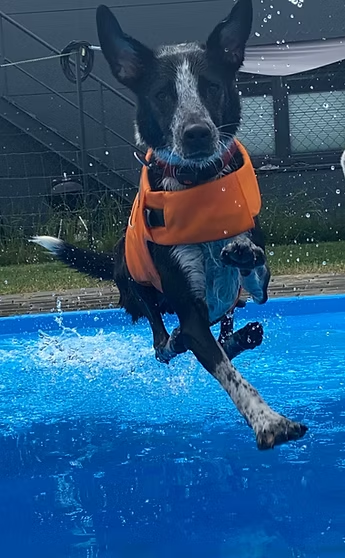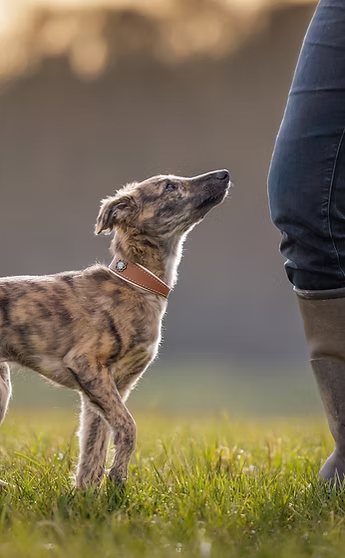Behind the Scenes with Nathalie from Fitdog.lu
- johannabaur01
- Aug 25
- 7 min read
Updated: 6 days ago

Taking care of our pets often means thinking about food, walks, and regular vet visits. But what about their mobility, comfort, and long-term health? That’s where Nathalie Janssen, founder of Fitdog.lu, comes in. As an animal physiotherapist, canine massage therapist, and canine fitness trainer, Nathalie has dedicated the last 10 years to helping dogs (and cats) stay active, recover from surgery or injury, and enjoy their golden years pain-free.
In this interview, Nathalie shares how her first dog Jake inspired her career, why physiotherapy should be seen as a first step, not a last resort, and what every pet owner should know about supporting their dog’s health at every age. Whether you have a bouncy puppy, a senior companion, or a pet recovering from surgery, Nathalie’s insights are packed with practical advice, myth-busting, and heartwarming stories.
👉 Read on to discover her journey, her passion for senior dogs, and why “old age is not a disease.”
She's exactly the kind of professional you’ll discover and support through Pet Pro Booking.
About Your Job
What inspired you to work with animals?
I’ve always loved dogs and wanted to do something with them but never knew what exactly. My first dog Jake, at the time, turned 17. He had hip dysplasia and developed arthritis. He inspired me to look into options for him. I found out about physiotherapy abroad because it wasn't available in Luxembourg. So I learned, went to college in the UK and then opened my own practice in Luxembourg.

How long have you been practicing, and what do you love most about your work?
I’ve been practicing for 10 years (April 2015). What I love the most is the satisfaction of having a dog being able to be mobile again, be pain free, live their life and be active.
What makes Fitdog special?
We are “Fear free” certified, so we work force free to reduce the animal´s stress. We put individualized treatment plans together for the best outcome for every client. Our niche (although we treat everything) is senior dogs, and we try to keep them mobile as long as possible into their golden age. We also specialise specifically in physiotherapy as this is a very new, large and ever evolving field. For me it was a conscious decision not to learn and offer several different or other treatments than physiotherapy as I don´t see how you can be good at everything. We prefer to be the best we can in what we do, which is physiotherapy. For instance for osteopathy and acupuncture we´ll refer to and work with professionals specialized in those fields specifically.
What types of pets or cases are closest to your heart?
Old dogs are close to my heart. I also have a special place for neurological post surgery patients (ex: disc hernia, dogs that are paralyzed) because I get to see them going from paralyzed to walking again. It’s not always an easy route, but it's so rewarding to see the results.
How do you build trust and reduce stress for pets and their owners at your practice?
For pets, we work fear-free. So we work a lot with treats and there is no forcing. We primarily work on the floor and won't force them to do anything. Almost all pets love coming to us and often pet owners comment on how their pets get excited in the car when they realize where they are going. For Pet owners, I think communication is key.
Physiotherapy & Pets
What's one thing you wish more owners knew or did for their pets?
Old age is not a disease! Just because they get old, doesn't mean that limping and slowing down is normal. Consider physical therapy for older dogs instead of assuming nothing can be done. It’s better to come earlier instead of waiting for signs. The sooner we start treating, the better. Most owners don’t come preventively, they come once they have a diagnosis, but even then, it’s important to come early in the diagnosis because that makes the success rate better. Physiotherapy should not be a last resort, but it should really be the first step. When the animals get really bad, we don’t get the same results as when a dog has been coming for years. So earlier is better and that way we can also monitor the dog´s evolution and intervene as soon as we remark changes, often even before the owners notice these.

What are the most common mistakes you see pet owners make concerning Physical Therapy?
Some common misconceptions: - “Physiotherapy = underwater treadmill.” -> There's so much more than that. - "Physiotherapists can make a diagnosis of what my dog has." -> We are not allowed to diagnose as this is the veterinarian's role. A physiotherapist visit does not replace a visit to the veterinarian, we are not an alternative to them but are complementary and we do not replace a veterinary diagnosis or treatment. Also, I want to emphasize that owner´s commitment is so important for your pet. You really need to work with your dog in between sessions, at home and ensure to do regular physiotherapy sessions. A good physiotherapist will give you a home management and home exercise plan. It makes you independent from us quicker.
How can pet owners better prepare their pets (and themselves) for a session?
For pet owners: You will stay with your pet, we prefer that. Also don't be stressed about what's happening here, it’s quite relaxed for pets, we´ll explain what we do and work with you to find the best solutions for your pet
For pets: Don't overfeed them before coming. Give them some time before coming to relieve themselves and take a little walk. Ideally, go to the vet and make sure you have a diagnosis and referral from the vet since we’re not allowed to diagnose. It’s not mandatory but it does make things easier, as we can work on the targeted issue.
What would you say to someone who's looking for a physical therapist but doesn't know where to start?
If you go online or get a recommendation from somebody, I would advise to check the credentials, verify they have done the proper training, and have a degree. The main reason is that it's a “non-regulated” profession, so there are no requirements to practice physical therapy. Also, once you go there, make sure you're comfortable with the professional, that you can explain things to them and that they will listen, explain and personalise a treatment for your pet and adapt this as needed to the pet´s condition.
About You
Do you have pets of your own? Tell us about them!
I currently have 2 dogs. Unfortunately Jake, the one who started it all, passed away at 17 years old. I have Jazz, a 6 year old rescue from Spain. She’s an Australian cattle dog cross. She has hip dysplasia, back issues and osteoarthritis (it’s very typical for veterinary professions to have dogs with sometimes not common diagnoses). And I have Jagger, a 6 month old puppy, a Silken Windsprite. They’re very active, love to run and race.
Can you share a moment or story that reminded you why you love your job?
I had a neurological case, a dog who was paralyzed from the front and hind legs from one day to the other. She had a quite low success expectancy from the vets. She had a disc hernia that paralyzed her on all 4 legs, but after some months, she was able to lead a normal active life again, walking and running again! The commitment from the owner to continue coming for regular treatments for several months was so important.
What’s your favorite thing to do when you’re not working with animals?
Working with my own animals! I love spending time with my dogs, traveling with my dogs and going to the beach. My dogs are sighthound dogs so we also love going to the racetrack for fun.
What’s something most people don’t know about being a Pet Physical Therapist?
There's a lot of learning involved! it’s not something you can learn over the weekend or in a short course. It's intensive study and continuous education because It’s an evolving field.
People don’t know this but we think about your dogs at night. For example for cases that don't work out how we hoped or are difficult to rehab or get progression on.
If you weren’t a physical therapist, what would you do?
I was a banker before! But if I was 18 again I would probably study human physiotherapy and continue into animals. I love my job, I wouldn't do anything else.
Special Tip for readers
Would you like to share a special tip for our readers this month?
Contact us to find out if your dog could benefit from physical therapy!
If you have an older dog, depending on breed it could be 6-8 years old: get a first physio check up, even if you think nothing is wrong. Dogs often don't show pain, they don’t cry. We can pick it up by examining them and watching their gait.
Just because they're active, playing and happy to go on a walk with you doesn't mean they dont have pain. Most pet owners don't realise their dog has an issue, unless it’s more severe. Dogs limp only when they reach a pain level of 6-7/10 on the pain scale. Which is already high!
Cats are even more difficult because they hide their pain even better. Arthritis is way less diagnosed in cats than dogs but it’s not less prevalent. It’s more complicated because some of them don’t like going places and being touched, but if they’re willing, get a checkup!
About Fitdog Sàrl-S

Address:
6, Rue de la Libération
L-7347 Steinsel
Website:
https://fitdog.lu/
Socials:
For Dogs & Cats
Services:
Physiotherapy
Massage and manual therapy
Rehab Exercises
Electrotherapy
Shockwave
Laser
UltraSound
Hydrotherapy
Fitness
Online Courses (more will follow!)
Seminars
Equipment rental for clients: home lasers, buggies and wheelchairs, harnesses
Products:
Joint supplements
Toegrips (anti slip device for dogs)
Protective shoes
Massage gel
Lickimats
Treats
Fitpaws Equipment
Who & What are they for:
All dogs from puppy to geriatric
Senior Dogs: mobility and maintenance
Post Surgery: orthopedic and neurological cases
Post injury
Arthritis management
Cats or other small animals
Fitness: for dogs of all ages that don't need rehab (healthy dogs)








